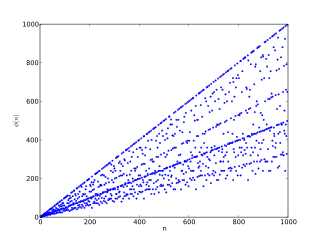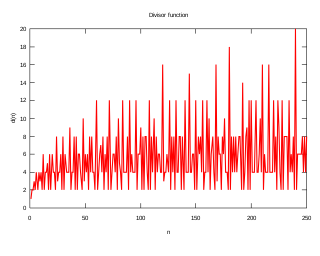
In number theory, Euler's totient function counts the positive integers up to a given integer n that are relatively prime to n. It is written using the Greek letter phi as or , and may also be called Euler's phi function. In other words, it is the number of integers k in the range 1 ≤ k ≤ n for which the greatest common divisor gcd(n, k) is equal to 1. The integers k of this form are sometimes referred to as totatives of n.
Golden ratio base is a non-integer positional numeral system that uses the golden ratio as its base. It is sometimes referred to as base-φ, golden mean base, phi-base, or, colloquially, phinary. Any non-negative real number can be represented as a base-φ numeral using only the digits 0 and 1, and avoiding the digit sequence "11" – this is called a standard form. A base-φ numeral that includes the digit sequence "11" can always be rewritten in standard form, using the algebraic properties of the base φ — most notably that φ1 + φ0 = φ2. For instance, 11φ = 100φ.

The Lucas sequence is an integer sequence named after the mathematician François Édouard Anatole Lucas (1842–1891), who studied both that sequence and the closely related Fibonacci sequence. Individual numbers in the Lucas sequence are known as Lucas numbers. Lucas numbers and Fibonacci numbers form complementary instances of Lucas sequences.

In mathematics, and specifically in number theory, a divisor function is an arithmetic function related to the divisors of an integer. When referred to as the divisor function, it counts the number of divisors of an integer. It appears in a number of remarkable identities, including relationships on the Riemann zeta function and the Eisenstein series of modular forms. Divisor functions were studied by Ramanujan, who gave a number of important congruences and identities; these are treated separately in the article Ramanujan's sum.
104 is the natural number following 103 and preceding 105.
400 is the natural number following 399 and preceding 401.
144 is the natural number following 143 and preceding 145. 144 is a dozen dozens, or one gross.
666 is the natural number following 665 and preceding 667.
500 is the natural number following 499 and preceding 501.
700 is the natural number following 699 and preceding 701.
600 is the natural number following 599 and preceding 601.
800 is the natural number following 799 and preceding 801.
900 is the natural number following 899 and preceding 901. It is the square of 30 and the sum of Euler's totient function for the first 54 positive integers. In base 10 it is a Harshad number. It is also the first number to be the square of a sphenic number.
135 is the natural number following 134 and preceding 136.
In mathematics, a prime power is a positive integer which is a positive integer power of a single prime number. For example: 7 = 71, 9 = 32 and 64 = 26 are prime powers, while 6 = 2 × 3, 12 = 22 × 3 and 36 = 62 = 22 × 32 are not.
225 is the natural number following 224 and preceding 226.
65535 is the integer after 65534 and before 65536.
In number theory, a perfect totient number is an integer that is equal to the sum of its iterated totients. That is, one applies the totient function to a number n, apply it again to the resulting totient, and so on, until the number 1 is reached, and adds together the resulting sequence of numbers; if the sum equals n, then n is a perfect totient number.
420 is the natural number following 419 and preceding 421.
In number theory, the totient summatory function is a summatory function of Euler's totient function defined by:




